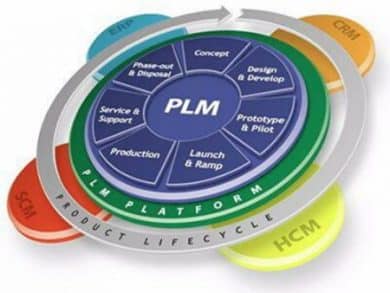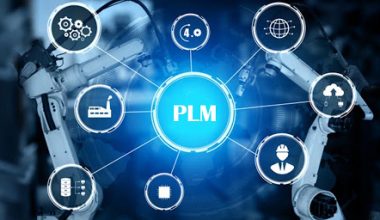Our world, in which the Internet of Things (IoT) is present in practically every product we use, is gradually becoming one in which big data reigns supreme.
Many experts recommend that we manage and use this data in natural ways. One such natural way is through product life cycle management (PLM) theory and software. PLM offers enormous scalability potential due to its ability to assist organize development strategies, information, and capabilities.
So, in this article, we will describe the stages and steps of the product lifecycle management (PLM) system, how it is organized, and present some examples. With the examples, you’ll also learn about the concepts and various lifecycles that overlap with and feed into the product lifecycle management, as well as the benefits and challenges to anticipate.
What is Product Lifecycle Management (PLM)?
Product lifecycle management (PLM) is the process of managing a product’s lifecycle from conception to sales, servicing, and eventually retirement.
PLM software, as a technology, assists firms in developing new products and bringing them to market. So, the program facilitates the tracking and sharing of data along the product value chain, from initial design to production, supply chain management and operations, and asset maintenance.
Product Lifecycle Management (PLM) Fundamentals
In an age when innovation is crucial to corporate survival and success, Product Lifecycle Management is critical in assisting manufacturers in developing the next generation of products at a reduced cost and with a faster time to market. While PLM can also be regarded as a business strategy, three fundamentals influence how teams function and businesses’ ability to grow and thrive:
- Access to and use of product definition information should be universal, secure, and managed.
- Maintaining the integrity of that product description and related information over the product’s life cycle
- Management and upkeep of the business processes that are used to develop, manage, disseminate, distribute, and utilize information
Advanced product lifecycle management PLM systems today improve and increase communication, break down silos, inspire and motivate teams to explore new ideas and record essential data to help mentor a workforce that may span multiple generations. As a result, PLM frees up the capacity, time, and experience that it requires to focus on what is most important – innovation.
Read Also: The Product Life Cycle Theory: Guide to the Stages & Examples
Five Stages of Product Development
There is no single industry standard for describing the stages of product development. The phases listed below, on the other hand, reflect a normal development cycle.
#1. Design and concept:
This is the ideation phase. So, here the requirements of a product are defined according to criteria such as competitive analysis, market gaps, or client demands.
#2. Develop:
The detailed design of the product, as well as any relevant tool designs, will be prepared. This phase comprises product validation and analysis, as well as prototype creation and field testing. Hence this phase also provides critical feedback on how the product is being utilized and what future improvements are required.
#3. Production and release:
The pilot’s feedback is utilized to fine-tune the design and other components in order to create a market-ready version. After scaling the new product’s production, market launch and distribution then follow.
#4. Service and assistance:
The time period following the debut of a new product during which service and support are provided.
#5. Retirement:
So, at the end of the product’s lifecycle, its exit from the market, as well as any retrials or absorption into other concept concepts, must be managed.
What is the Functionality of a Product Lifecycle Management (PLM) system?
A product lifecycle management PLM system provides designers and engineers with real-time access to vital data. The system automates project management by connecting CAD (computer-aided design) data with a bill of materials and other corporate data sources, such as integration with an ERP system. Also, it manages the product data throughout the product development lifecycle.
A Product Lifecycle Management system also prevents designers and engineers from working in a vacuum. So, it provides them with access to external sources of information such as customer and analyst feedback on current products, performance data on products in the field, and visibility into the limitations of downstream processes such as manufacturing.
A Product Lifecycle Management system supports teams in ways other than design and engineering. It can also provide visibility to business stakeholders and/or suppliers as a “single source of truth”. So, this is for easy feedback delivery early in the product development process.
Product Lifecycle Management (PLM) evolution
American Motors Corporation (AMC) was a minor player in the automotive business in the 1980s. The company lacked the massive budgets of the market’s larger participants, limiting its ability to compete effectively. So, the first iteration of the product lifecycle management proposition was by AMC leadership. They also wanted to optimize procedures and compete more efficiently by tracking products from inception to end-of-life.
The information gained was used to make better decisions throughout the process, from ideation to procurement and production. AMC increased its market share and was ultimately purchased by Chrysler, becoming the auto industry’s lowest-cost producer by the mid-1990s.
Product Lifecycle Management is in use throughout the manufacturing industry. The use is to stimulate collaboration, boost innovation, and efficiently support growth. So, they achieve this by designing to client demand and product individualization.
Also, in an era of digital transformation and accelerated change – Forbes estimates that COVID-19 will result in five years of innovation in manufacturing over the next 18 months. Hence, PLM is crucial in assisting companies in bringing goods to market faster.
Benefits of Product Lifecycle Management
Industry Week highlighted the major reasons why organizations opt to invest in PLM based on a poll of more than 200 engineering and R&D professionals.
#1. Improvements in development, engineering efficiency, and effectiveness
According to the findings of an Industry Week poll, silos pose the greatest obstacle to engineering team performance. So, PLM allows for the bi-directional flow of real-time data, which promotes improved knowledge-sharing and collaboration.
#2. Error elimination during the engineering release process
It is significantly easier – and less expensive – to correct product defects that are recognized early on. PLM helps to minimize costs while also providing an environmental advantage by minimizing production waste.
#3. Reduced time to market
By providing a single source of truth with up-to-date information at every stage of the product lifecycle, PLM enables project managers to control overlapping timeframes and bring products to market more quickly.
#4. Improved project delivery
A digital PLM solution that is cross-enterprise provides better workflow management. In this application, PLM enables a team to precisely assess product costs. Also, they can manage the transition to manufacturing new designs more effectively.
#5. Higher quality designs
PLM provides designers and engineers with a deeper level of knowledge of product requirements, resulting in higher quality designs. A PLM system with integrated machine learning can turn performance statistics and customer input into new feature proposals by ingesting data from a variety of internal and external sources.
Let’s see some real-world examples of companies utilizing product lifecycle management.
Product Lifecycle Management Examples PLM
Product Lifecycle Management (PLM) systems are widely utilized in the manufacturing industry. Aerospace, automobile, and defense are important industries. These three companies are examples utilizing product lifecycle management in novel ways:
#1. Humboldt Wedag, a cement industry leader, developed a responsive, future-proof PLM solution. The solution allows employees to collaborate on design processes in many languages and across three continents.
#2. Kaeser Kompressoren, a prominent manufacturer and supplier of compressed air solutions, improved the design process for new products with a centralized solution that promotes collaboration and efficiency.
#3. Sartorius, a multinational biopharmaceutical research and life sciences industry partner, enhanced product development by providing a unified view of all product data to increase quality management and productivity.
Overcoming Product Lifecycle Management (PLM) Challenges
Currently, less than half of R&D executives think they have complete visibility into the design-to-delivery process. This demonstrates that, for many firms, PLM has yet to realize its full potential as a single source of product truth.
Furthermore, the increased adoption of Industry 4.0 processes in manufacturing has resulted in an exponential increase in the volume of data relevant to products throughout their existence. This is a big opportunity. However, that is if there is proper recording and evaluation of data- emphasizing the importance of integrated AI and machine learning.
Finally, many Product Lifecycle Management PLM proponents struggle to articulate the software’s importance beyond engineering. In all of the preceding situations, investing in a solution that interacts with existing enterprise systems – and includes built-in artificial intelligence – will boost the use and value that the organization as a whole may gain.
Product Lifecycle Management (PLM) and Technology in the Future
The pressures to beat competitors to market, attract top people, and produce the finest quality product possible will only grow. PLM can help firms achieve these objectives with quicker design and product engineering cycles, but only if they invest in the necessary technologies.
With the Internet of Things (IoT), more items are coming online. So, designers and engineers stand to gain significantly greater visibility into products in the field, as well as the opportunity to update products that are already in the hands of consumers. According to McKinsey, this allows manufacturers to continue developing new consumer value throughout the product’s lifecycle.
PLM systems, like other types of enterprise software, are increasingly being delivered as software as a service on the cloud (SaaS). This will make PLM more affordable to smaller businesses while also fostering the collaboration required by effective product development teams as workforces become more spread.
Digital twins are virtual models of a product that are controlled within PLM systems and are connected to their actual ‘twin’ via IoT. Although the concept is still in its early stages, digital twins’ expectations are to produce considerable cost savings for manufacturers in the coming years. So, according to IDC, “by 2023, 65 percent of global manufacturers would have seen a 10% reduction in operational expenses due to the use of digital twins powered by IoT and machine learning.”
How can PLM support digital transformation in the manufacturing industry?
By streamlining product development processes and facilitating increased collaboration and information sharing among cross-functional teams, PLM can support digital transformation. As an added bonus, it can serve as a consolidated database for product information and facilitate businesses’ shift toward digital product definition and management.
What is the difference between PLM and ERP systems?
Whereas ERP (Enterprise Resource Planning) systems are concerned with managing a company’s core business processes like finance, human resources, and supply chain management, PLM (Product Lifecycle Management) is concerned with managing product-related data and processes throughout the product lifecycle. A more comprehensive picture of a business’s operations is obtained when PLM is combined with ERP software.
How can PLM help manage product obsolescence?
By serving as a central repository for product data and by keeping track of the various stages of the product lifecycle, including the end-of-life, PLM can aid in the management of product obsolescence. Use this data to foresee and prepare for product obsolescence issues and retirements.
What are the key features of a good PLM solution?
Features like product data management, collaboration and communication tools, change management, and lifecycle stage tracking are essential for a PLM solution. In addition to being secure to guard proprietary information and proprietary products, it must be adaptable and scalable to meet the evolving needs of the company.
How does PLM enhance product quality and reliability?
By serving as a hub for all relevant product data and facilitating improved coordination and communication across departments, PLM can greatly improve the quality and dependability of the final product. This can help guarantee that the data used to make product design and development decisions is as up-to-date and accurate as possible.
How does PLM support cost management during product development?
By serving as a centralized database for product data, including cost information, PLM can aid in cost management. The team can then use this information to make educated decisions about the product’s design and development, taking into account things like the total cost of manufacturing, the total cost of materials, and the total cost of regulatory compliance. Furthermore, PLM can aid in lowering the possibility of cost overruns due to product development delays.
Product Lifecycle Management (PLM) Frequently Asked Questions
What is a Product Life Cycle?
The term “product life cycle” refers to the stages that a product goes through from conception through retirement. Ideation, design, prototype, manufacture, service, and end-of-life management are all included.
What is a Product Lifecycle Management PLM Software System?
A product lifecycle management (PLM) software system is used in manufacturing to manage a product and its associated data throughout all stages of the product lifetime. While primarily utilized by design and engineering teams working with CAD data, a PLM system can provide all business stakeholders with access to the product design process.
What is the Difference Between Product Lifecycle Management and Product Data Management?
PDM only captures and maintains information on products during their development and usable life, but PLM may handle all aspects of the product throughout its existence.
What is product development software?
Product development software is a term that refers to solutions that aid in the development of new goods. Product roadmaps, data analysis, a communication tool, work assignment, and issue tracking are all possible features.
- PLM SOFTWARE: Best Product Lifecycle Management Software Reviews & Comparisons
- The Product Life Cycle Theory: Guide to the Stages & Examples
- The Product Life Cycle: Stages, Examples and Marketing Strategy
- Cost-plus Pricing Strategies: Formula and Examples
- AMAZON AUTOMATION: Overview, Scam, Investments, Store






